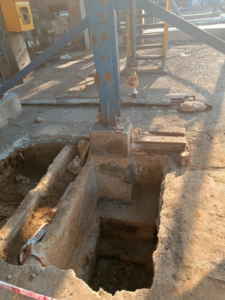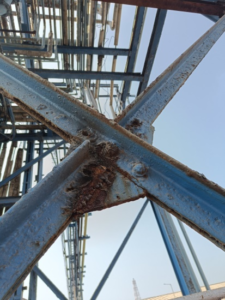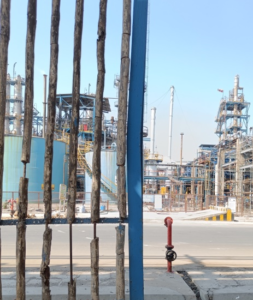Structural Health Assessment / Structure Audit
- Introduction
A structural assessment is a procedure utilized to check the adequacy, structural integrity and soundness of structures and their components. An assessment is made to evaluate a structures current and future use and conformance to current building codes.
All buildings and structures require periodical inspection to ensure structural safety, strength and stability under normal/actual loads as well as reducing the possibility of disproportionate collapse under unanticipated or accidental loads.
The consequences of having insufficient structural integrity can be a danger to public safety – meaning the building may not be able to support the loads that it was designed for.
Empire Industrial Services evaluation process involves visual observations of structural members such as columns, beams, joists, load bearing walls, slabs, roof decking, foundations, and connections for any signs of structural deficiencies such as cracks, excessive movements, bowing, deflections, differential settlements, including any evidence of distress and material deterioration. Our Professional Engineers assess the structural elements ensuring that they will continue to safely perform their intended function.



2.Importance of structural health assessment
Any structure after its construction deteriorates due to loading or environmental impacts. Thus, there is a variation in the strength of the structure after it is built in place. If this variation is under a certain threshold limit, the structure is considered as damage-free; otherwise, the structure is considered as damaged, which, eventually may fail. Here, the damage is defined as changes to the material and/or geometric properties of a structural system, which adversely affects the system’s performance. SHA is effective in several ways, as follows:
– Detection of damages during and after construction, which can cause any change in properties than expected by design.
– Meet the requirements of much longer service life as proposed in Modern design codes.
– For extension of Service life and reduce operational risk.
– Acts an early warning system to avoid any further economic loss and casualties.
– Cost-effective and reliable inspection solutions to ensure the safety and reliability of the structures, thereby eliminating the hidden costs of any damages.
– Essential to monitor the structures built in areas prone to natural disasters.
– Assess improvement in the performance of the structure after Retrofitting.
3.Methods for structural health assessment
Responses are the important aspects of a structure, which can be commonly measured and be divided in as: a) Mechanical: Strain, Deformation, Displacement, Cracks opening, Stress, Load etc. b) Physical: Temperature, Humidity, Pore pressure etc. c) Chemical: Chloride/ Sulphate/ Carbonization penetration, pH, Rebar oxidation etc. 2 SHA has been practiced for centuries and has evolved over the years. The earlier methods were usually based on Visual Inspection and instrument-based Non-Destructive Testing (NDT). The instrument-based NDT included Schmidt’s Hammer Test, Ultrasonic Test, Radiographic Test, Eddy Current Test, Magnetic Particle Test, and Thermal Infrared Test. Most of these methods are non-model based and demand the inspector to be experienced and skilled.
4.Recommendations for improving structural heath assessment
Recommendations for improving Structural Health Assessment (SHA) to improve the quality of structures, a) It should be ensured that SHA is used right from the start of the construction process, during the construction, occupancy & until the end of life of the structure. This will result in increased quality, reduced maintenance costs and prolonged life of the structures. b) Use of the modern-day solutions such as the Internet of Things, Cloud computing, Unsupervised Machine Learning algorithms can give a new direction to SHA. c) The legal standards and design codes can be revised to make SHA mandatory as keeping our structures safe to avoid all the subsequent damages is entirely into National interest. d) Increased awareness is one of the major factors for widespread use of SHA techniques.
Our Other Services
- Rebound Hammer
- Ultrasonic Pulse Velocity
- Half Cell Potentials
- Concrete Core
- Carbonation
- Cover Meter Survey
- Pile Integrity Test
- Pile Dynamic Test
- Bridge Load Test
- Slab Load Test
- Cross Hole Sonic Test
- In-Situ Metallography (Replica)
- Portable Hardness Test (Rebound & UCI Method)
- Expert Metallurgy Consultant For Site
- Pressure Vessel Inspection & Maintenance
- Condition Assessment
- Remaining Life Assessment
- Fitness For Service
- Pipeline Inspection & Maintenance
- Tank Inspection & Maintenance
- IBR/Non IBR Fabrication
- Structural Health Assessment / Structure Audit
- Reactor Inspection As Per Factory Act





